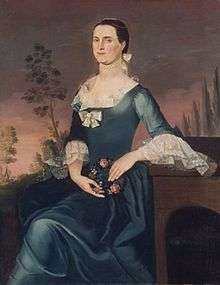William Johnston (painter)
William Johnston (1732 – April, 1772) was a colonial American painter. He was the first painter to spend any significant amount of time in Connecticut, and was active in Portsmouth, New Hampshire as well.[1]

Johnston was born in Boston, Massachusetts, one of the four sons of the japanner Thomas Johnston and his wife, Rachel Thwing.[1] His brother John became a painter as well.[2] John Smibert and Peter Pelham were among the family's neighbors, and William was a friend of John Singleton Copley, who was six years his junior; he likely also knew the latter's half-brother, Henry Pelham.[2] He began his career as a musician, serving as organist at Boston's Christ Church from 1750 to 1753, before he decided to become a painter.[1] This career, too, he began in Boston, but for many years no works from his early career were known until a pair of portraits in the Metropolitan Museum of Art were identified as his.[2] He traveled next to Portsmouth, New Hampshire for work, living there from 1759 until 1762. Next he moved to Connecticut, remaining in the colony for at least three years; during his sojourn there he worked in New London, New Haven, and the area around Hartford.[1] He was the first painter to work there – residents previously having to travel to Boston, Newport, or New York City to be painted – and may have been lured there by his sister, Susan Hobby, who lived in Middletown.[1] He counted a number of members of the most prominent families in Connecticut, including the Mumfords, among his patrons.[3]
Johnston returned to Boston sometime before 1766.[1] On December 2 of that year he married Christy Bruce, widow of Samuel Bruce, becoming stepfather to her two children.[2] He had moved to Barbados by 1770, continuing to find work as a portraitist and receiving seventy-five pounds a year to play the organ;[1] a letter from that year to Copley makes no mention of his wife or stepchildren, suggesting that they had by this point died.[2] The letter also requests a portrait of his sister, Mrs. Hobby, from Copley.[1] Johnston himself died in Bridgetown relatively soon thereafter, in April, 1772, apparently of a sudden illness.[2] Interment was in the parish church of St. Michael. Johnston left a will in which his possessions were bequeathed to Rachel Beckles, sister of Barbados attorney general Henry Beckles. His death was noted in the Boston press.[1]
Stylistically, Johnston's work is very similar to that of his friend Copley, adopting similar poses and many of the stylistic characteristics of his early work; indeed, at least three of Johnston's portraits have been misidentified as those of the younger artist in past years.[2] His paintings also suggest the influence of Joseph Blackburn, who was painting in Portsmouth at the same time he was there, although his style is more linear.[1] He was generally comfortable working in a three-quarter length format; his greatest difficulty lay in attaching the sitter's head to the body.[1] Many of his poses and backgrounds are drawn from English mezzotints of the period.[3] Today two of Johston's paintings may be found in the Metropolitan Museum of Art,[2] while one is owned by the Connecticut Historical Society,[1] and another is owned by the Brooklyn Museum of Art.[3]
| Wikimedia Commons has media related to William Johnston (1732–1772). |
References
- Richard H. Saunders; Ellen Gross Miles; National Portrait Gallery (Smithsonian Institution) (1987). American colonial portraits, 1700–1776. Published by the Smithsonian Institution Press for the National Portrait Gallery. ISBN 978-0-87474-695-2.
- John Caldwell; Oswaldo Rodriguez Roque; Dale T. Johnson (1 March 1994). American Paintings in The Metropolitan Museum of Art. Vol. 1: A Catalogue of Works by Artists Born by 1815. Metropolitan Museum of Art. pp. 51–. GGKEY:5A107H6P5DU.
- "Brooklyn Museum: American Art: Mrs. Thomas Mumford VI". brooklynmuseum.org. Retrieved 10 May 2015.